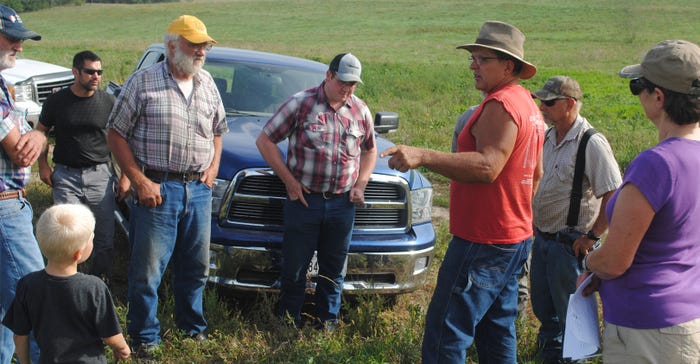
Pat Steffen is farming the same land where he and his siblings grew up, near Fordyce, Neb., in Cedar County. But Steffen and his wife, Julie, along with their son Robert and his wife, Laura, are farming the land in a much different way.
For more than 30 years, the Steffen operation has evolved into a grass-based system that takes advantage of native prairie pastures that remain essentially the same as they were hundreds of years ago, combined with highly productive lowland pastures that were reseeded to a grass and legume mixture after several decades of row crop farming.
To make their grass production systems pay, the Steffen family direct markets grass-finished beef to local beef customers. They also custom graze cattle for neighbors. For the Steffens, thinking about grass, soil health and the prairie is a philosophy that lends itself to the name of their farm — Prairie Blossom Trails.
“Back in the late 1980s, we attended some holistic management courses with Alan Savory,” Pat Steffen recalls. “At that time, with our variable soils, we decided that we didn’t want to till the ground.”
Steffen and his family had endured too many drought years on the land. “Things would look great, and then all of a sudden, they would dry up,” he says. “We were tired of that.”
No-till farming wasn’t as popular or as possible then in Nebraska as it is today, so farming the grass seemed like a viable option for the Steffens to mitigate drought. “We didn’t have a lot of money invested in machinery,” Steffen says. “That made the transition to grass an easier decision.”
About half of the farm had never been tilled and continues to be virgin prairie. On the other half, they started the transition on terraced land, by overseeding warm-season grass and legumes in the fall into grain sorghum and oat stubble after the crop was harvested. The diverse mixture included big bluestem, little bluestem, indiangrass, switchgrass, orchard grass, clovers and alfalfa.
“We didn’t wait to graze the new seeding,” Steffen explains. “We just started lightly grazing the new seeding the following spring.” They built fencing that includes high-tensile wire as perimeter fence; 12-gauge steel wire around the paddocks; and poly electric wire as paddock subdivision fences.
They built and added water lines and water points to facilitate the movement of cattle through a series of paddocks on a daily basis, without using any additional funding from federal programs that would pop up later — such as the Natural Resources Conservation Service Environmental Quality Incentives Program.
“Over the first six or seven years, I changed the fencing several times and redid the plans, adding more water lines,” Steffen says. “Those changes gave us more flexibility.” In the early years, they grazed Angus-Hereford cross cows. They also grazed stocker calves briefly.
“We made a lot of mistakes early on,” Steffen admits. “Over time, we began to custom graze for neighbors. Then, in 1999, we bought four Scottish Highland cows and began building our own herd from there. As we built up our own herd, we cut back on the custom grazing.”
The Highland cattle are a specialty breed, so there is not much of a market for calves that aren’t sold directly for meat or as purebreds for breeders, Steffen says. Highland cattle are a smaller-framed species, but they finish slower on grass.
Over time, the Steffens developed a network of grass-fed meat customers from across the region. This past year, they added Red Devon cattle to their herd, so they could not only market crossbred calves direct to customers for grass-finished beef, but they also could sell additional animals into the conventional feeder market if they needed to.
The animals on the Steffen farm do not receive grain and graze almost year around. Pat Steffen harvests limited quantities of baled forages and purchases baled hay when he needs to. Even the bales are fed in pasture paddocks in the winter months, and the cattle are moved between paddocks for feeding.
“When we first started grazing, the bottomland paddocks didn’t have the root structure to hold up to the native prairie as far as traffic and feeding hay,” Steffen says. “In the early years, the seeded paddocks couldn’t take heavy traffic.”
Now, they are not quite as solid as the prairie, but the seeded paddocks have improved greatly.
“Our whole philosophy is to improve the health of the land, the soil and the grass,” Steffen says. “That’s why we move our cattle daily, or maybe give the cattle two days of grazing if we are tight on time.”
Having started grazing and grass management when they were just married, today Pat and Julie continue to work on a farm transition plan to the next generation that includes their son Robert and his wife, Laura, and their children.
“I’m not ready to retire at all,” Steffen says. “But we don’t want to run the risk of our grandchildren not developing that strong attachment to the farm and to carry on,” he says.
While the road for them hasn’t always been easy, Pat and Julie have not only made their living from the farm and kept their goals intact, but they have shared their experiences through pasture walks and tours. One such walk took place this past fall, hosted by Nebraska Extension educator Ben Beckman.
After more than 30 years on the farm, the Steffens have continued to learn and improve their grass management and grass-finishing techniques, and to share what they’ve learned with others. Now, they are working to hand the farm and all that they’ve learned on to the next generation.
Learn more by emailing the Steffen family at [email protected].
About the Author(s)
You May Also Like






